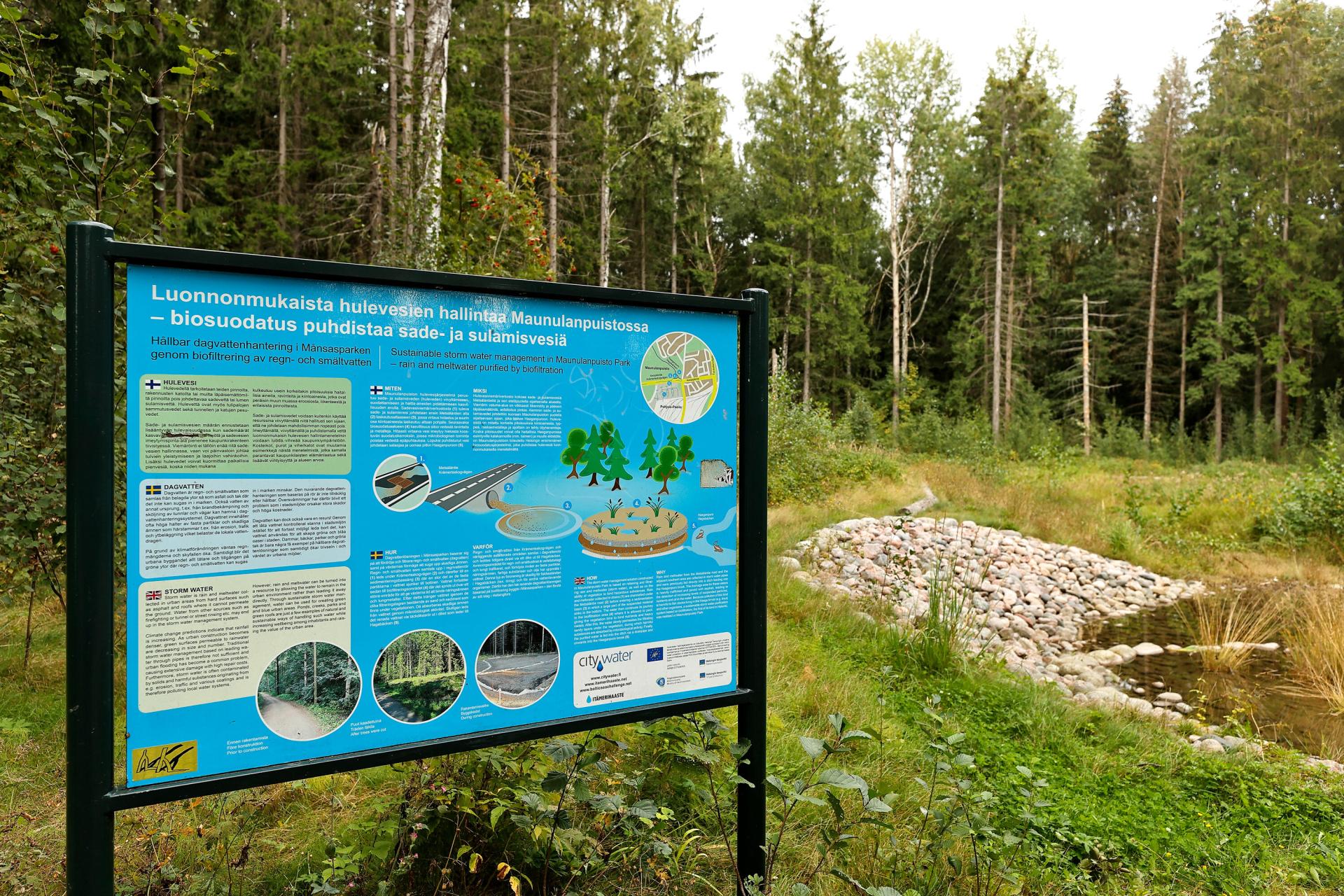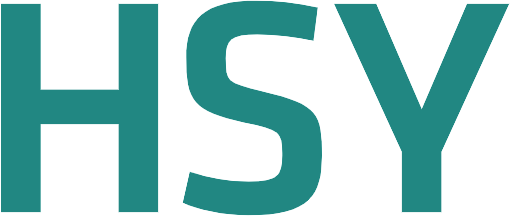Nature-based solutions for stormwater management in the Helsinki Metropolitan Area, Finland – Prerequisites and good practices
Information
Helsinki Region Environmental Services Authority
30.12.2021
Nature-based solutions for stormwater management in the Helsinki Metropolitan Area, Finland – Prerequisites and good practices
Helsinki Region Environmental Services Authority
P.O. BOX 100
00066 HSY
Tel +358 9 1561 2110
Faksi 09 1561 2011
www.hsy.fi
Author: Niina Kautto
Further information:
Maaria Parry, maaria.parry@hsy.fi
Cover photo: HSY/ Mikko Käkelä
Selected stormwater management solutions in Helsinki
City of Helsinki is growing fast. The population is currently circa 657 000 inhabitants, and it is estimated to go beyond 700 000 in 2028 and reach 824 500 inhabitants by 2050. That means that the population is expected to increase by 200 000 inhabitants by 2057. (Helsingin kaupunki 2021b).
City of Helsinki has the highest built-up area among the metropolitan cities, 39% (Figure
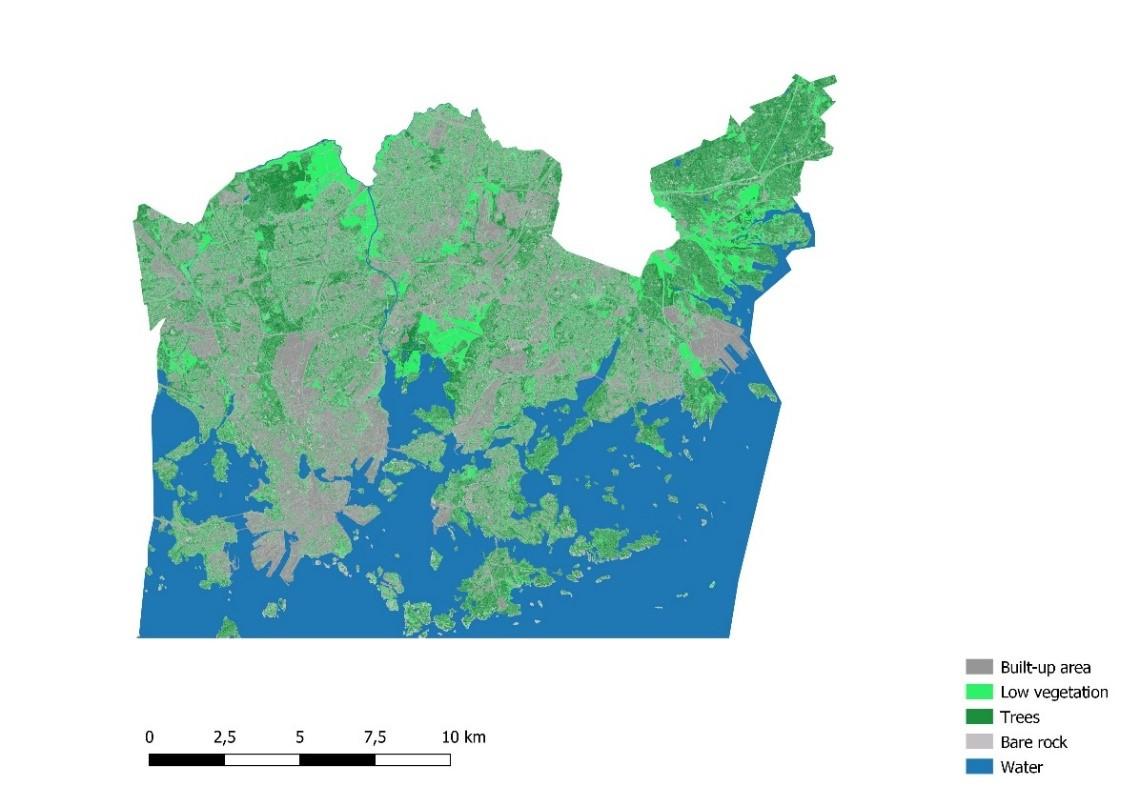
To accommodate the growing population, the city needs to build new areas and make the city structure denser. Managing stormwater in a sustainable way has been recognised in the Helsinki City Strategy 2017-2021, “The Most Functional City in the World”, that calls for an increase in the amount of green areas in the city structure so as to promote cost-efficient stormwater management. Also, the new city strategy for 2021-2025 mentions the intention to increase green infrastructure to manage stormwaters and support climate adaptation. Utilisation of stormwater along with proper management advance also other city strategy objectives such as attractiveness of the environment, biodiversity, good state of small watercourses and adaptation to climate change. (City of Helsinki 2018, Helsingin kaupunki 2021c, Peltosaari et al. 2020).
The city developed its Storm Water Management Program in 2018 as part of the climate change adaptation strategy work. In addition to this strategic work, an update to the 2008 stormwater strategy was driven by changes in stormwater legislation as well as city management systems and organisational structures. The current Storm Water Management Program is integrated in its nature, which means that the program’s measures are implemented and developed as an integral part of city planning, construction, and other related processes, mainly within the existing operational budgets. The Storm Water Management Program was carried out within the iWater project (European Regional Development Fund, Interreg Central Baltic). (City of Helsinki 2018, Peltosaari et al. 2020).
The Storm Water Management Program includes six objectives and 38 measures. These objectives are (City of Helsinki 2018):
- Stormwater has been utilised for increasing the attractiveness of the environment, maintaining biodiversity and promoting a good condition of surface and groundwater.
- Regional and local drainage has been ensured while taking the impacts of climate change into account.
- The disadvantages caused by storm water have been prevented and eliminated in changing conditions and densifying city structure.
- Stormwater flow rates are under control and stormwater quality is improved.
- Conveying stormwater into wastewater sewer has been reduced.
- Cooperation and procedure models supporting systematic overall management of stormwater are in use, and sufficient competence and resources have been secured.
The management, treatment and conveying of stormwater follows the priority order set by the national level stormwater legislation. Various services of the city’s Urban Environment Division and so-called stormwater group are responsible for the implementation of the program measures. The measures are implemented in cooperation with other city services and divisions, HSY as well as different stakeholders and residents. (City of Helsinki 2018, Peltosaari et al. 2020).
The stormwater group consists of representatives of different services of the Urban Environment Division. It is primarily responsible for the last objective, including measures that concern the development of a cooperation and operations model, training of stormwater issues within the city organization, as well as monitoring and reporting of the implementation of the program. (City of Helsinki 2018, Peltosaari et al. 2020).
To assist with the implementation of the stormwater program and aim to increase green areas in the city, City of Helsinki uses a planning tool called the Green Factor. This tool provides means to account for the quantity and quality of green space. The tool has been developed to support land use planning processes, and is intended to be used by city planners, landscape architects and garden designers. Using the Green Factor tool is required in the zoning regulations and following building permits. (City of Helsinki 2018, City of Helsinki Environment Centre 2016, Juhola 2018, informant).
City of Helsinki is in the process of investigating nature-based stormwater management sites. Thus far there has not been a systematic mapping of such sites, and the knowledge has mostly been held by city staff dealing with city planning. Now the idea is to digitalise the data on the sites and transfer that onto a map. Therefore, there is not yet a maintenance card file of stormwater management sites but this process can found a basis for such a card file. (informant).
The selected sites in Helsinki consider the Kuninkaantammi ecological district (Fannynkallio residential area, Helene Schjerfbeck’s park) and the biofiltration area in the Maunulanpuisto park. Other sites worth mentioning in the city are for instance the Vauhtitie wetland in Töölönlahti bay (Tengbom, n.d.), and the Maunulanpuro brook biochar-based filtration area next to the Maunulanpuisto park biofiltration area (Helsingin kaupunki and Espoon kaupunki 2020). Recent studies that have looked into nature-based solutions in Helsinki include Kyyhkynen (2021) and Suni (2021).
Kuninkaantammi ecological district
Location: Kaarela neighbourhood, Hakuninmaa
Management / system type: on source management, conveying, detention & infiltration
Land use types: Developing (or rural) area / densely built-up area / green or natural area
Built: 2013/2015-2027 (pre-building started in 2013, building of houses in 2015; Helene Schjerfbeck’s park 2015-2018; Fannynkallio finished 2019) (Helsingin kaupunki 2015, 2021d; Laitinen 2021)
Size: Whole district 120 ha, Helene Schjerfbeck’s park ~10 ha (Helsingin kaupunki 2021d)
Catchment basin: Mätäjoki river, Vantaanjoki river (Sanaslahti 2019)
Description:
Kuninkaantammi is a developing district in the City of Helsinki, and it is halfway being built. It has formerly been mainly an industrial area that is being transformed into a climate friendly neighbourhood for 5,500 inhabitants. The district has taken as its starting point both climate change mitigation and adaptation. Buildings are energy efficient and use renewable energy. The district acts as a pilot area for stormwater management, in which new design solutions will be seen in parks and residential areas. The intention of this project is also to increase the cooperation of different city departments on the implementation of the city’s stormwater program and to clarify the responsibilities of various actors. (Helsingin kaupunki 2015, 2016, 2020; Ilmasto-opas.fi 2014).
The town plan of Kuninkaantammi requires that the stormwaters from the impermeable surfaces need to be detained in the area so that the detention depressions, basins and containers need to be 0,5 m3/ 100 m2 of impermeable surface area. The town plan also necessitates rain gardens in the residential areas as the primary means to detain stormwater. In addition, green (or vegetated) roofs are required to be built on all single-level buildings namely for the purposes of detaining stormwater. (Ilmasto-opas.fi 2014).
Infiltration of stormwater on site is possible only to a certain extent in Kuninkaantammi due to the ground being rocky and frictional soil; hence the stormwaters are infiltrated and detained partly via nature-based solutions on yards and streets until the stormwater is conveyed to Helene Schjerfbeck’s park and into Mätäjoki and Vantaanjoki rivers (Helsingin kaupunki 2020, Sanaslahti 2019). Treating and detaining stormwater in Kuninkaantammi is vital as conveying stormwater directly through the piping structure would lead to the flooding of streams in the residential area of Hakuninmaa (Helsingin kaupunki 2020).
While the capital investment cost of constructing the Kuninkaantammi stormwater management system is relatively high (e.g. Helene Schjerfbeck’s park’s stormwater structure costs were estimated in 2008 as 2,3 M€ (Helsingin kaupunginhallitus 2014)), nature-based (or natural as discussed in secti
Kuninkaantammi’s stormwater structures are reported to be monitored on how they function and how they are maintained (informant). While it is still rather early to determine how well the stormwater pilot area is functioning especially from the stormwater quality point of view (Kyyhkynen 2021), one study has investigated whether the stormwater management solutions of Kuninkaantammi have affected the water quality in Hakuninmaanoja stream when comparing the period before construction to after the construction of Kuninkaantammi district (2011-2018)(Sanaslahti 2019). Helene Schjerfbeck’s park was built before the construction of the housing areas in order to treat the stormwaters during construction before they were lead to Mätäjoki river (Helsingin kaupunginhallitus 2014). The study concludes that the water quality of Hakuninmaanoja stream seems satisfactory or good regarding most variables studied regardless of the construction activities. The stormwater solutions in the area during construction (rain gardens in the yards as well as the detention and retention pools of the Helene Schjerfbeck’s park) have resulted in low peak concentrations of suspended solids and total phosphorus when compared to prior studies on water quality changes due to construction. The study suggests that the stormwater pilot area is functioning successfully. (Sanaslahti 2019).
Fannynkallio residential area
Fannynkallio residential area is located on the northwest edge of the district. It was finished in 2019 and includes circa 100 apartments (see Fig. 10-12). The main design principle was a diverse vegetation that utilises the conveyed surface waters. Rain gardens, that infiltrate and filtrate, and lastly evaporate water through the ground layers were built on all yards. The topography of the yard was designed so that surface waters are directed to the rain gardens. Rain gardens consist of detention depressions, stormwater ponds and vegetation layers. If the ponds are filled, water is directed to stormwater pipes via an overflow structure. (Laitinen 2021).
Inhabitants of the Fannynkallio block have also planter boxes in use, which can be watered with surface water collected in containers and accessed via a hand pump. Stormwater allows for a functioning ecosystem when leaf mass is increased and there is more vegetation. (Laitinen 2021).
Stormwaters have been taken into account also in many surfaces and pavings. On walkways, permeable pavements were preferred instead of asphalt: stone ash, gravel and grass stone. Yard areas were covered with forest floor shrub-land transplant that retains water efficiently. (Laitinen 2021).
Green roofs that evaporate water were installed on low yard buildings and carports. The green roofs consist of a rubber bitumen layer to protect the water insulation, a growth layer and a thin layer of sedum plants on top (Laitinen 2021).
The Fannynkallio stormwater solution is a result from a cooperation of different types of planners, namely the garden/yard planner, geo technic planner and HVAC planner. The work was framed by the town plan of the City of Helsinki requiring the use of the Green Factor. (Laitinen 2021).
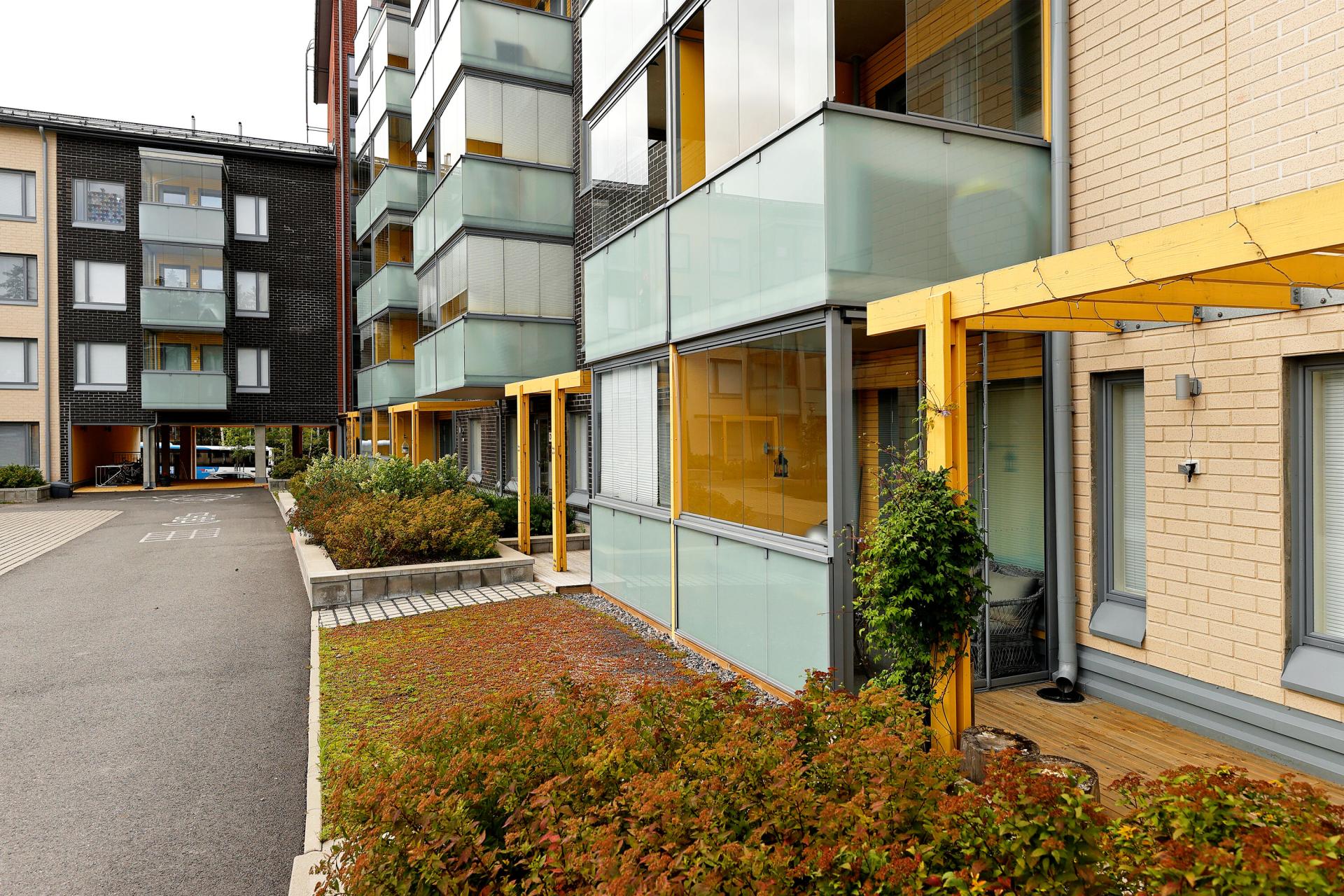
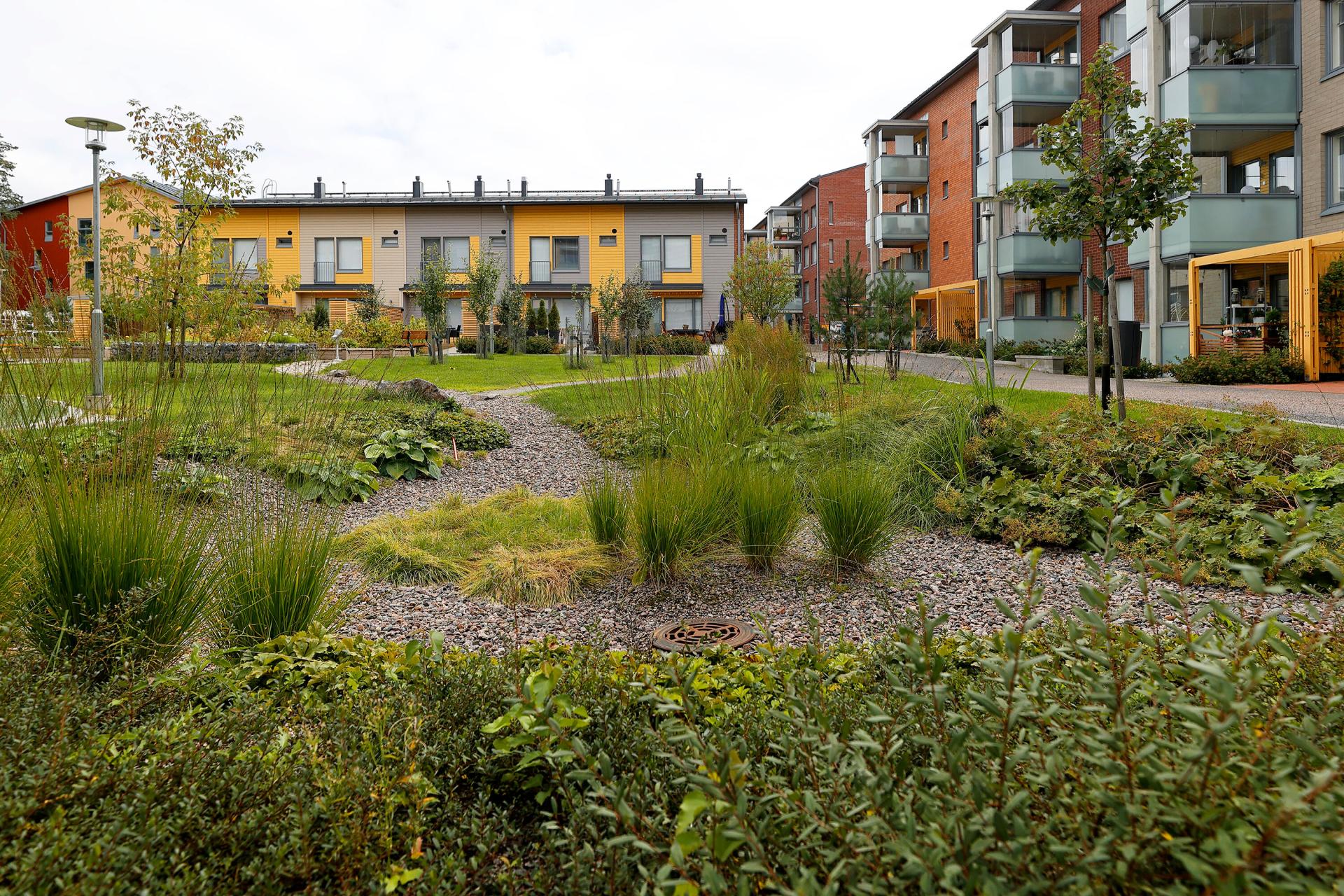
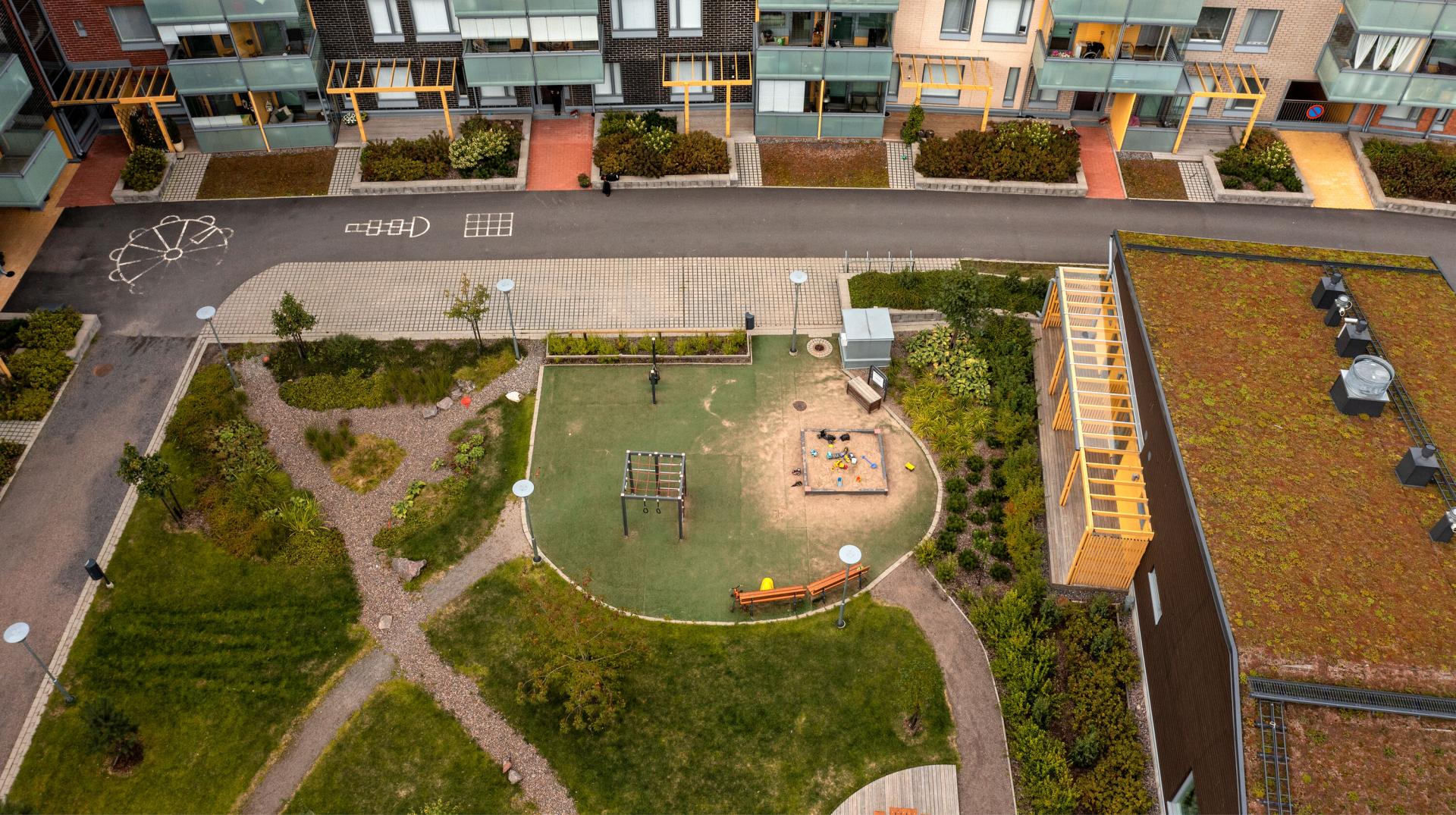
Helene Schjerfbeck’s park
Helene Schjerfbeck’s park is one of the most significant projects in the district (see Fig. 13-15). It has been built out of a natural, forested area of Hakuninmaanpuisto parkland, on the south side of the district as part of the nature-based stormwater management system with retention basins and meadow wetlands. The park acts as a flood meadow in which plant islands symbolise the palette colours of the famous Finnish painter Helene Schjerfbeck. The park exhibits the application of the latest knowledge of handling stormwater at the place of origin, and conveying them to wetlands and pools detaining the water. What is noteworthy, open water surfaces are made visible in the design and stormwater is a central and prominent element in the park. (Helsingin kaupunki 2015, 2016; Ilmasto-opas.fi 2014).
On the north edge of the park, the waters are conveyed through cascading rock formations towards the wetlands in the centre of the park. Water has also been brought to the kids’ play area. Water is conveyed to the wetlands through meandering channels that are partly wetlands-like or grass covered depressions, partly streams with gravel or rock surfaced streams. Wetlands are expected to increase the biodiversity of flora and fauna in the area. (Helsingin kaupunki 2015; Ilmasto-opas.fi 2014).
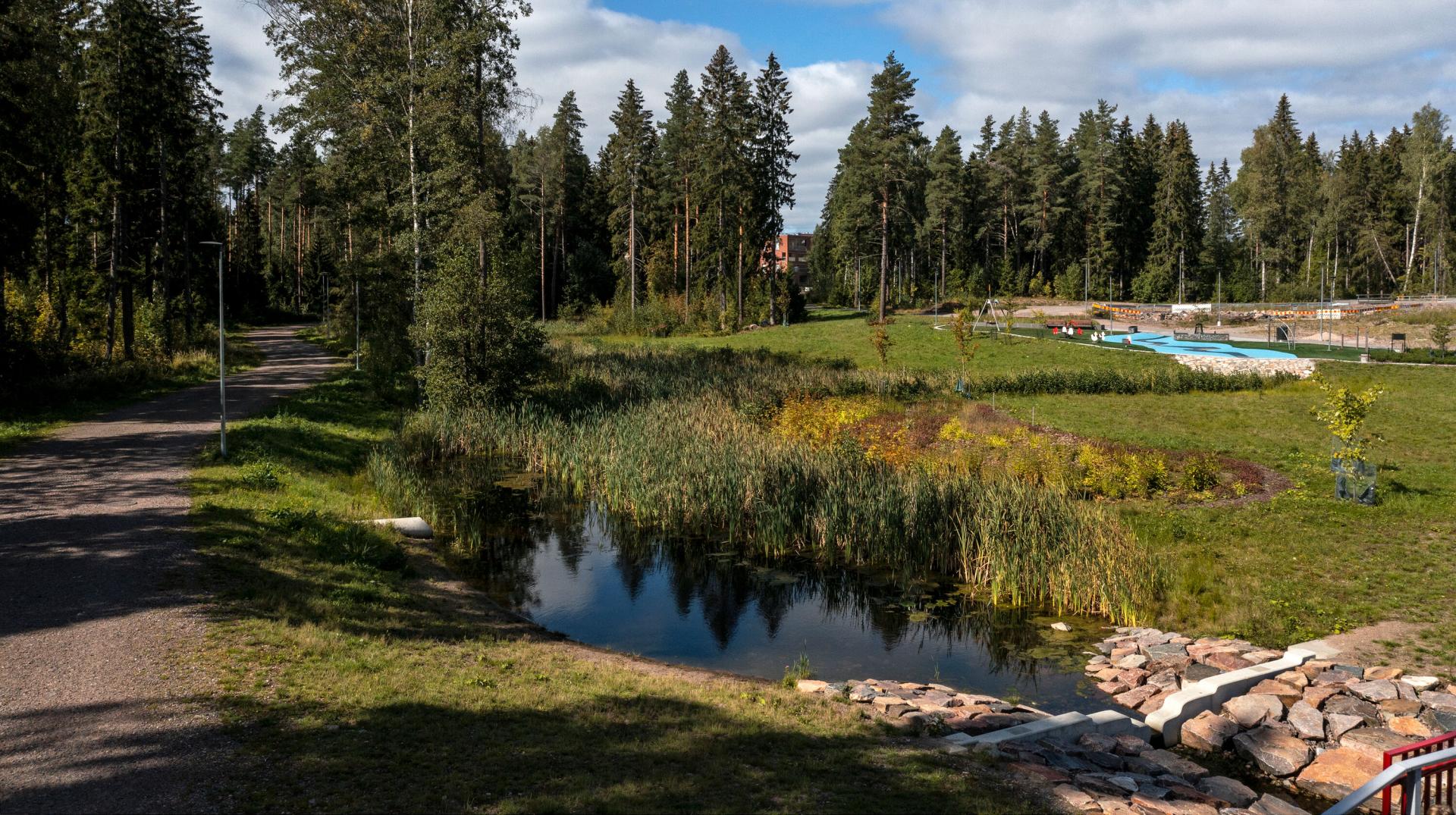
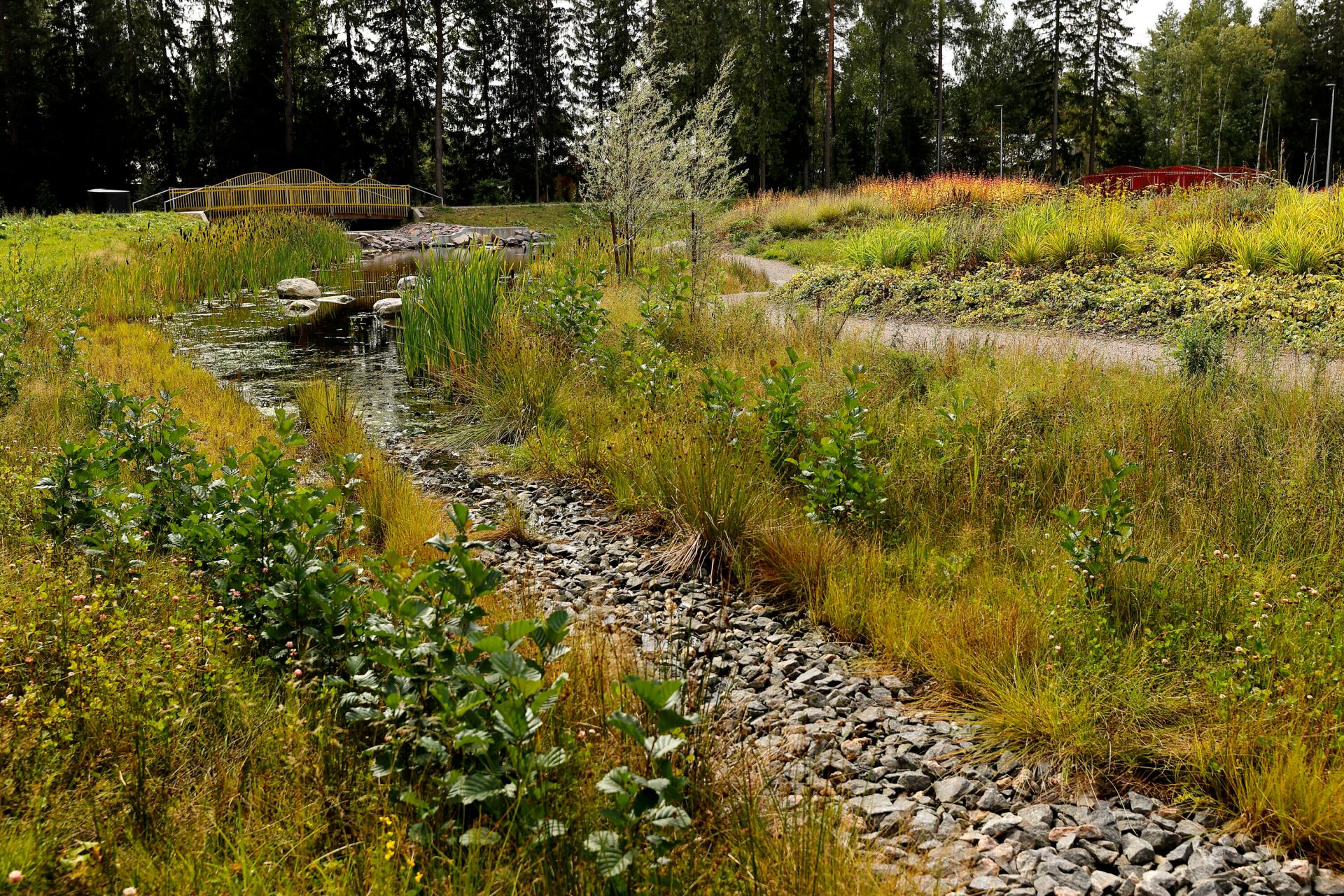
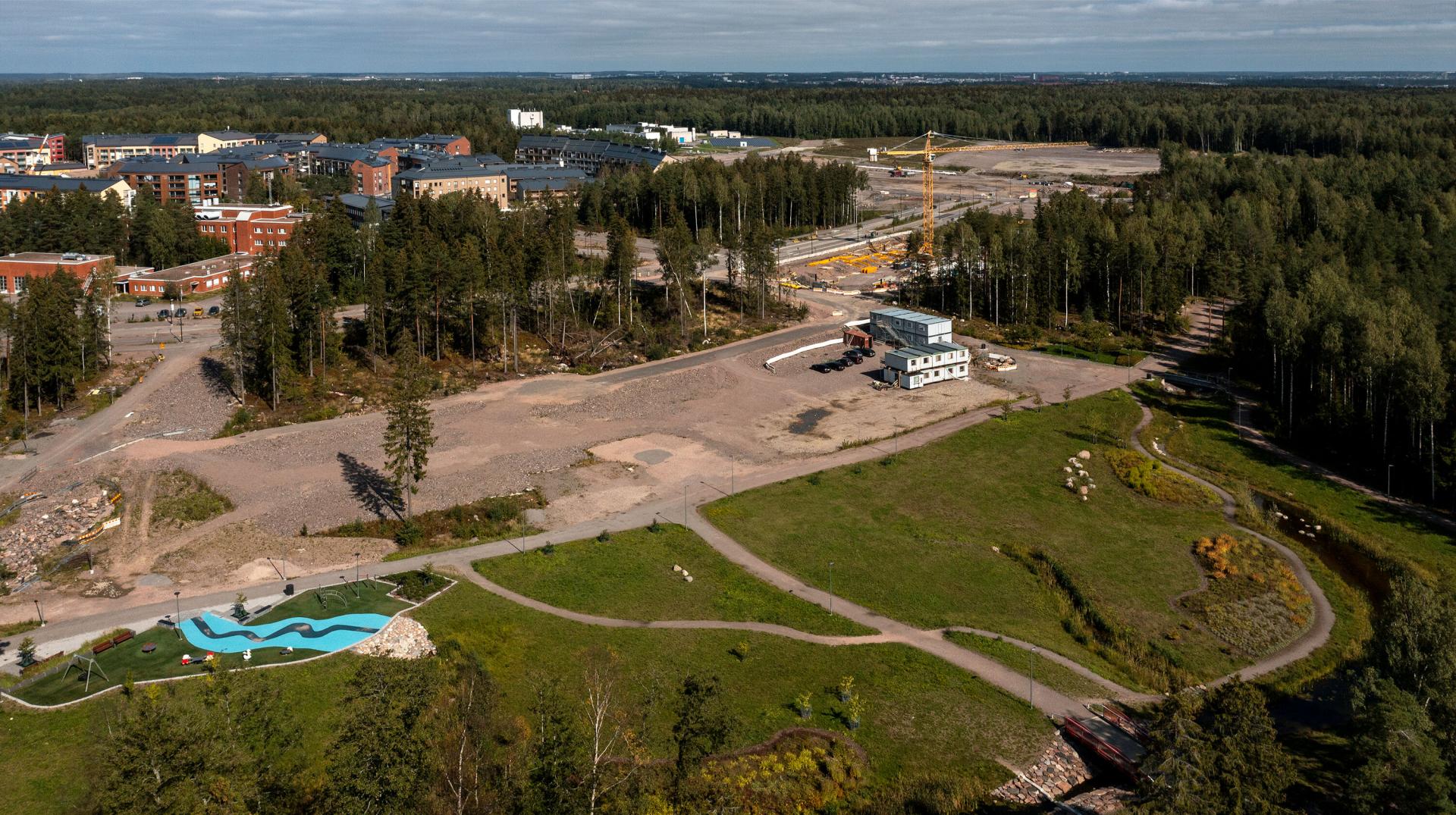
Maunulanpuisto park biofiltration area
Location: North Pasila, Central Park
Management / system type: detention & infiltration
Land use type: green or natural area
Built: finalised in 2015
Size: 700 m2 (biofiltration system (Peltosaari et al. 2020))
Drainage area: 15 ha (Rosqvist 2015)
Catchment basin: Haaganpuro brook
Description:
Maunulanpuisto park biofiltration area was built in 2015 to handle stormwaters from Metsäläntie road and former transport centre (Maaliikennekeskus) (Rosqvist 2015, Yleisten töiden lautakunta 2015) (see Fig. 16-19). It is located in a park that has been dedicated to recreation in the town plan, and the project was planned so that it would not harm the significant nature values in the area (Yleisten töiden lautakunta 2015). The purpose of the structure is to purify and detain stormwaters before they are directed to Haaganpuro brook using biofiltration as a natural stormwater management solution (Yleisten töiden lautakunta 2015). The Haaganpuro brook inhabits a breeding salmon population, which is extremely vulnerable for suspended solids carried e.g. by stormwaters (informant). The solutionalso acted as a pilot to test the biofiltration method as it was the first site of its kind in Helsinki at the time (Anonymous 2016, Yleisten töiden lautakunta 2015). The structure’s detention volume-capacity ratio is measured to about 85% once a year in 60 min rain, and about 100% once in 2 years in 60 min rain (FCG 2015).
The stormwaters collected from Metsäläntie road with heavy traffic and the industrial area – containing 74% impervious surface – were found to contain increased heavy metal and nitrogen concentrations as well as nutrients, PAH compounds, and occasionally oil due to oil leakages (Rosqvist 2015, Yleisten töiden lautakunta 2015). These were harming the fish stock (sea trout and whitefish) breeding in the Haaganpuro brook (Peltosaari et al. 2020, Rosqvist 2015).
This solution was realised within the “CITYWATER- Benchmarking water protection in cities” project (2012-2015) co-funded by the European Union LIFE+ programme and the Finnish Ministry of the Environment (Baltic Smart Water Hub 2017, Peltosaari et al. 2020). The stormwater management system consists of a sedimentation basin and a biofiltration area of planted vegetation (Peltosaari et al. 2020). Stormwaters collected from the road and industrial area are conveyed via pipes to the sedimentation basin that removes solids from the water by sinking them to the bottom (Baltic Smart Water Hub 2017). Then the water is directed to the biofiltration area that allows the water to pool, and that has been planted with vegetation (flooding meadow and wetland plants (Anonymous 2016)) binding nutrients and heavy metals. (Baltic Smart Water Hub 2017). The project benefited from previous research on vegetation, e.g. creeping red fescue was known to bind and utilise hydrocarbons; clovers PAH compounds, nitrogen and phosphorus; and willows heavy metals (Yleisten töiden lautakunta 2015). Water permeating slowly through sandy layers under the vegetation help purify the water even more when harmful substances are absorbed by microbial activity. The purified water is eventually fed into a ditch via a drainpipe and onwards to the Haaganpuro brook. (Baltic Smart Water Hub 2017). The site includes an information board to provide information on the function of the biofiltration area.
The construction costs were 220 000 € (Baltic Smart Water Hub 2017). At the outset of the project, around 5000 € /year (without VAT) was reserved for the maintenance (Yleisten töiden lautakunta 2015).
With regard to the maintenance, the structure requires annual checks to make sure it is functioning as planned. This may demand small repairs e.g. due to erosion and cleaning of rubbish. The vegetation is cut back when needed, or in early autumn (August/September). The basins need dredging to remove sedimented material circa every 3-5 years. Biofiltration layers must be renewed every 10 years. However, the need for biofiltration may decrease in the coming years due to former transport centre turned into living and business areas of which stormwaters will presumably be cleaner. (FCG 2015, Baltic Smart Water Hub 2017, Rosqvist 2015).
To monitor the functionality of the structure, water samples have been taken from the area infrequently: in 2017 every second month, and in 2019-2020 altogether six times. Based on this monitoring, it is determined that the biofiltration structure purifies well phosphorus and heavy metals (e.g. copper, lead and zinc) as well as PAH compounds and oil; it also effectively cleans suspended solids. No impact was found on nitrogen. (Baltic Smart Water Hub 2017 (discussion dated 2019), informant).
More information of the purification performance will be available in the beginning of year 2022; the City of Helsinki is currently investigating the water quality improvement performance of a few of its nature-based stormwater management solution sites, including Maunulanpuisto park biofiltration area. (informant).
There are some lessons learnt from the project. One should reserve 1-2 years for the planning stage, including setting aims, gathering key persons committing to the project, considering needed permits and assessments, budgeting, choosing a consulting company to plan the solution and informing local residents (Rosqvist 2015). It is reported that the planning of the stormwater management structure was made in tight cooperation with different actors: the group directing the work of the consultant consisted of members from the departments of public works, urban planning, building inspection and environment centre to consider different views and engage the actors to the project. The park plan of the stormwater management structure was presented to the residents in late 2014; they considered the protection of the Haaganpuro brook important, and cleaning of the stormwaters flowing into the brook was deemed necessary. (Yleisten töiden lautakunta 2015).
The construction stage can take 0,5-1 year and then one should have all essential construction related documents ready (such as construction plan, water service plans and map with soil and sediment information). Additional documents supporting the construction plan include cost estimates as well as a management plan for use and maintenance. (Rosqvist 2015).

